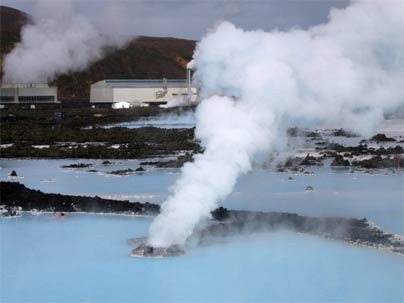Icelanders, who get most of their heating, hot water and a good portion of their electricity from geothermal sources, are well aware that Reykjavik, which means "Smoky Bay," is named for the steam from the local hot springs. In the United States, especially in the non-volcanic northeast, we don't tend to think about geothermal energy.
Jefferson Tester, the H.P. Meissner Professor of Chemical Engineering, thinks that should change. "Unless you're from Iceland, you don't make the connection to thinking about geothermal. We're trying to increase awareness that this technology may not be as far away as people think," he said at an MIT Museum Soap Box event Feb. 7.
Tester, who headed an MIT-led study of the potential for ramping up geothermal energy within the United States, spoke on "Geothermal--An Undervalued Primary U.S. Energy Source" at the Soap Box, one of a series of salon-style, early-evening conversations on ideas and issues in science and engineering.
Tester said that although geothermal energy is produced commercially today, existing U.S. plants have focused on the high-grade geothermal systems primarily located in isolated regions of the west. Using enhanced geothermal system (EGS) technology would greatly increase the fraction of the U.S. geothermal resource that could be recovered commercially, he said.
The United States, generating 300 megawatts, is already the biggest producer of geothermal. "If geothermal is going to be anything more than a minor curiosity, it has to reach at least the level of hydro and nuclear power, or 100,000 megawatts out of 1 million--one-tenth of total capacity," he said. Geothermal would be a particularly attractive way to replace the high proportion of electricity that comes from coal-fired plants, which contribute to global warming.
The technology to achieve EGS borrows heavily from oil and gas drilling that already exists. "We're talking about instead of mining minerals out of the ground, we're mining heat," he said. Although the $600 to $800 million price tag seems hefty, Tester pointed out that it is less than the cost of "one big clean coal plant," which would cost roughly $1 billion.
Tester was part of the 18-member panel that prepared the 400-plus page study, "The Future of Geothermal Energy," for the U.S. Department of Energy.
The study found that mining the huge amounts of heat that reside as stored thermal energy in the Earth's hard rock crust could supply a substantial portion of the electricity the United States will need in the future, probably at competitive prices and with minimal environmental impact.
The process involves drilling to as deep as 30,000 feet, pumping water under pressure into fractures to break apart underground rock formations and freeing up reservoirs. Seismic activity is a risk, he said. "The big challenge is to show you can do it not only in California, but also in the Midwest and ultimately on the East Coast, where you have to go deeper." Among geothermal's advantages are its below-ground, out-of-sight nature, making it easier to site, and its high capacity. Unlike solar and wind, which only work when the sun shines and the wind blows, geothermal runs all the time.
"We're hoping people won't walk away from this thinking it is too far out," Tester said. "I want to make sure we're looking at all options."
A version of this article appeared in MIT Tech Talk on February 14, 2007 (download PDF).






